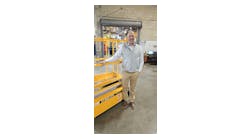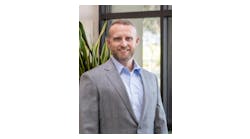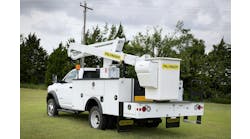Interview with Sinoboom’s Joey Liu: The Rise of Big Data
Joey Liu, marketing specialist, Sinoboom North America talks about the impact of electric vehicles and AI; pothole protection and tilt sensors; an anti-crash system for MEWPS; charging solutions; and more.
RER: What do you see as some of the new trends in mobile elevating work platforms and telehandlers (not just with your company’s products). What are customers particularly looking for?
Liu: A significant trend in MEWPs is the shift towards electrification, driven by the global green movement and the need for sustainability. Countries like the U.S., Europe, Australia, and especially China are seeing a rise in electric and hybrid models, not only for aerial platforms but also for heavier equipment. While slab scissors have already achieved high levels of electrification (around 95 percent), other types of booms are steadily adopting electric power. This trend is expected to grow over the next five years, especially in North America.
Additionally, the use of artificial intelligence (AI) is becoming more prevalent, particularly in tasks that are repetitive or labor-intensive. AI enhances productivity, lowers labor costs, and increases safety. The rise of big data and IoT is transforming fleet management, enabling smarter and more efficient control of rental fleets through telematics and predictive maintenance. These combined trends reflect a broader push toward more efficient, environmentally conscious, and technologically advanced equipment in the MEWP industry.
What improvements are being made in the aerial industry in regard to safety, in your products and in the industry as a whole? Are there particular areas of safety you feel need to be addressed more, i.e., falls from height, electrocutions, entrapments, tools falling out of platforms, etc.?
Safety is a top priority in the aerial industry, and our products are equipped with multiple features to minimize risks. Our access deck provides secure platform access, while load sensing, pothole protection, and tilt sensors enhance stability and help prevent accidents. The foot switch adds an extra layer of protection, preventing unintended activation, and the platform mesh ensures tools stay in place, safeguarding workers below.
Across the industry, there's a growing emphasis on improving operator training and integrating smart technologies to reduce human error. We're actively developing and refining new safety solutions, including an anti-crash system for AWPs that detects hazards in real-time, a secondary guarding device for entrapment prevention, and enhanced platform mesh.
How much have rental companies improved in regard to safety practices and training their customers in safety in recent years? How would you like to see improvement in this area?
At Sinoboom, we've seen significant progress in how rental companies have improved their safety practices and training offerings for customers. We provide comprehensive enhanced training programs, including IPAF-certified training and onsite machine-specific training by our experts, to ensure operators are fully prepared to use our aerial work platforms safely. In addition, we offer telematics and data-driven safety solutions, allowing rental companies to monitor machine usage and operator behavior in real time, giving valuable insights into safety risks. For added convenience, we’ve developed an online training dashboard, accessible via a QR code decal on the machine, where operators can complete training modules at their own pace. While these initiatives have led to greater safety across the board, we continue to innovate by looking at further improvements, such as more frequent recertification options and personalized, site-specific safety training, to meet the evolving needs of the industry.
What are the main new developments in your company’s products?
All electric scissor lifts:
The Sinoboom 1932ME All electric scissor lift is designed to meet the needs of modern construction and maintenance tasks with its efficient performance, compact design and eco-friendly operation. The 1932ME All stands out with its completely hydraulic-free design, eliminating the risk of hydraulic leaks and reducing maintenance needs.The electric system reduces the total cost of ownership by minimizing maintenance requirements and maximizing uptime.
Lithium-Powered Electric Booms with Extension Range Module (ERM):
The ERM enhances the efficiency of electric boom lifts, delivering substantial cost savings and increased productivity for construction projects. It is compatible with models such as the TB660EJ Plus and TB860EJ Plus. Charging times: 3 hours for the TB660EJP Li and 4 hours for the TB860EJP Li (from 30 percent to 80 percent).
The modular design allows for easy installation and transfer between machines, while the intelligent monitoring system provides real-time data on equipment status and energy consumption, ensuring optimized performance. The 150-liter diesel fuel tank supports up to 30 charging cycles, and the lithium-powered smart battery is equipped with self-warming technology for temperatures below 0°C.
We continually ask manufacturers and rental companies about electric and hybrid aerial machines, and we find demand and acceptance is increasing each year, along with improved charging infrastructure on jobsites. Do you agree with this? What are your expectations for this market in the foreseeable future, particularly in rental?
We agree. Based on AEM data we could see the growth of electric MEWPs in the industry. Especially as jobsite regulations become more stringent regarding emissions and noise control. The hybrid and electric machines are particularly appealing for indoor use, urban environments, and job sites where sustainability goals are being prioritized.
Rental companies are also starting to adapt by offering charging solutions and services, making it easier for customers to rent and operate electric machines without worrying about charging limitations.






